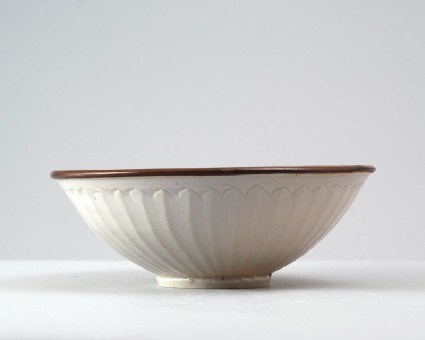The Barlow Collection
A select catalogue of the Barlow collection of Chinese Ceramics, Bronzes and Jades by the University of Sussex (published Sussex, 2006).

Publications online: 456 objects
White ware bowl with floral decoration
- loan
-
Literature notes
This bowl has three characters, the name Wu Mingzhi, moulded onto three leaves, faintly visible. Such ‘signatures’ are extremely rare on Chinese ceramics. It is therefore not clear whether this would be the name of the maker or of a patron.
The rounded conical bowl has a thin straight foot and is slightly flared at the rim. The centre inside is clearly indicated and indistinctly moulded with a floral motif, the sides with a peony scroll with a multitude of flowers and leaves, evenly filling the space but leaving a band at the rim plain. The outside is carved with simple petals with pointed tips. The translucent glaze has a faint blue tinge and fully covers foot and base but leaves the rim free, which has been covered by a copper band. -
Details
- Associated place
- Date
-
13th - 14th century (1201 - 1400)
Southern Song Dynasty (1127 - 1279)
Yuan Dynasty (1279 - 1368)
- Material and technique
- porcelain, thrown, with press-moulded and carved decoration under a bluish-white glaze (qingbai ware); copper rim; glazed base
- Dimensions
-
6.8 cm (height)
18.7 cm (diameter)
- Material index
- Technique index
-
formed › moulded › press moulded,
- Object type index
- No. of items
- 1
- Credit line
- Lent by the Sir Alan Barlow Collection Trust.
- Accession no.
- LI1301.123
-
Further reading
University of Sussex, and Arts and Humanities Research Council, The Barlow Collection, supervised by Regina Krahl, Maurice Howard, and Aiden Leeves (Sussex: University of Sussex, 2006), no. C97
Glossary (2)
glaze, porcelain
-
glaze
Vitreous coating applied to the surface of a ceramic to make it impermeable or for decorative effect.
-
porcelain
Ceramic material composed of kaolin, quartz, and feldspar which is fired to a temperature of c.1350-1400⁰c. The resulting ceramic is vitreous, translucent, and white in colour.
Location
-
- currently in research collection
Objects are sometimes moved to a different location. Our object location data is usually updated on a monthly basis. Contact the Jameel Study Centre if you are planning to visit the museum to see a particular object on display, or would like to arrange an appointment to see an object in our reserve collections.
Publications online
-

The Barlow Collection
This bowl has three characters, the name Wu Mingzhi, moulded onto three leaves, faintly visible. Such ‘signatures’ are extremely rare on Chinese ceramics. It is therefore not clear whether this would be the name of the maker or of a patron.
The rounded conical bowl has a thin straight foot and is slightly flared at the rim. The centre inside is clearly indicated and indistinctly moulded with a floral motif, the sides with a peony scroll with a multitude of flowers and leaves, evenly filling the space but leaving a band at the rim plain. The outside is carved with simple petals with pointed tips. The translucent glaze has a faint blue tinge and fully covers foot and base but leaves the rim free, which has been covered by a copper band.
Notice
Object information may not accurately reflect the actual contents of the original publication, since our online objects contain current information held in our collections database. Click on 'buy this publication' to purchase printed versions of our online publications, where available, or contact the Jameel Study Centre to arrange access to books on our collections that are now out of print.
© 2013 University of Oxford - Ashmolean Museum



